I am taking my Hot Stove editor to dinner on Wednesday night. It will be our 37th Wedding Anniversary. To further celebrate, Rita has arranged a baseball stadium tour (June 18-24) that will take us to Pittsburgh, Cleveland, Cincinnati, Nashville and Atlanta.
In other news, our eyes are on the Belmont Stakes to be run next Saturday. Three years ago, on the very day of our 34th Wedding Anniversary, American Pharoah won the Belmont to become the only Triple Crown winner during our marriage. Will Justify make it two?
Triple Crown Watch: On May 5, Justify won the Kentucky Derby at Churchill Downs in Louisville. On May 19, he repeated with a win in the Preakness Stakes at Pimlico Race Course in Baltimore. Both wins were on very muddy tracks. Next Saturday, at the 150th running of the Belmont Stakes in New York, Justify will make his run for the final jewel of the Triple Crown. Post Time: 5:37 CDT.
From 1919 to 2017 (a total of 99 runnings), 12 horses have won the Triple Crown. With a win at Belmont, Justify would increase that number to 13.
In baseball during that same 99 years, 12 (or 13) players have won the Triple Crown, eight in the American League and four (or five) in the National League. Mookie Betts of the Red Sox looks like the best “bett” this season to increase the number to 13 (or 14).
For the uninitiated, you need to know that to win horse racing’s Triple Crown, a horse must win the Kentucky Derby, Preakness Stakes and Belmont Stakes in the same racing season.
In baseball, a batter needs to be the best in his league for the season in batting average, home runs and runs batted in.
In horse racing, you know quickly if there will be a new Triple Crown winner – three races held within a 5-week period. In baseball, it takes 162 games over some six months.
The National League: In the 19th century, two players won the Triple Crown in the NL. Since then, four (or five) have done so:
1912 – Heinie Zimmerman – Chicago Cubs (probably; see below)
1922 – Rogers Hornsby – St. Louis Cardinals
1925 – Rogers Hornsby – St. Louis Cardinals
1933 – Chuck Klein – Philadelphia Phillies
1937 – Joe Medwick – St. Louis Cardinals
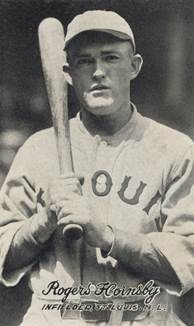
If you check Baseball Reference, Heinie Zimmerman is given credit for a Triple Crown in 1912. But in Wikipedia and Baseball Almanac, Heinie gets only a footnote. The discrepancy relates to the calculation of RBIs. This was not an official statistic until 1920, and so researchers have had to retroactively study box scores to work up RBI numbers. This is not an exact science, and during the research process, Heinie has both lost and gained RBIs. The most recent reports seem to favor Heinie.
The American League: The American League was founded in 1901. A couple of early era players won the Triple Crown: Nap Lajoie in 1901 and Ty Cobb in 1909. This was in the dead-ball era with Lajoie needing only 14 homers to lead in that category and Cobb even less at 9. After the live-ball era got underway in 1920, the AL has had eight winners:
1933 – Jimmie Foxx – Philadelphia Athletics
1934 – Lou Gehrig – New York Yankees
1942 – Ted Williams – Boston Red Sox
1947 – Ted Williams – Boston Red Sox
1956 – Mickey Mantle – New York Yankees
1966 – Frank Robinson – Baltimore Orioles
1967 – Carl Yastrzemski – Boston Red Sox
2012 – Miguel Cabrera – Detroit Tigers
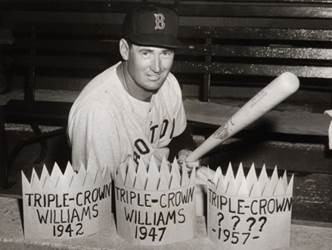
As suggested in the above photo, Ted made a run at the Triple Crown in 1957, hitting at a .388 pace, but he fell a little short in homers and RBIs. He came even closer in 1949. He led the league in home runs and RBIs, and going in to the last day of the season, he led in average. But Detroit’s George Kell went 2 for 3 (against future Hall of Famers Bob Lemon and Bob Feller) while Ted went 0 for 2. They both rounded to an average of .343, but going out another decimal point, Kell won with .3429 over Ted’s .3427. No Triple Crown.
Babe Ruth may have had the most dominant non-Triple Crown season. In 1921, he hit 59 home runs (the runner-up had 24). He knocked in 171 runs (the runner-up, 139). He also hit .378. But that was only good for third behind two Tigers, Harry Heilmann (.394) and Ty Cobb (.389).
Miguel Cabrera took the Triple Crown In 2012, and many assumed this should be enough to also anoint him as MVP of the American League. After all, it was the first Triple Crown in 45 years. But Mike Trout had a lot of support because he led the league in WAR, the more comprehensive modern stat that combines hitting, fielding and base-running. In the end, nostalgia for the Triple Crown (and a very good season) won out and Cabrera was named MVP.
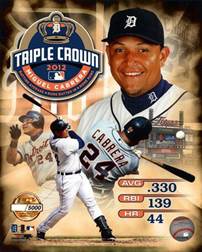
Derby/Preakness/Belmont: The first running of the Derby was in 1875. The Preakness, 1873. The Belmont, 1867. The races have been run every year except for three at the Preakness and two at the Belmont. Each race is for three-year-old Thoroughbreds (the capitalized term refers to the line of horses from certain breeds).
No horse ran in all three races until War Cloud did so in 1918. Although War Cloud won only the Preakness, his attempt to win all three prestigious races inspired the owner of Sir Barton to give it a try in 1919. Sir Barton won all three of what would later be coined as the “Triple Crown of Thoroughbred Racing.”
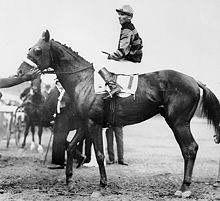
Sir Barton at 1919 Preakness
The complete list of Triple Crown winners:
1919 – Sir Barton
1930 – Gallant Fox
1935 – Omaha
1937 – War Admiral
1941 – Whirlaway
1943 – Count Fleet
1946 – Assault
1948 – Citation
1973 – Secretariat
1977 – Seattle Slew
1978 – Affirmed
2015 – American Pharoah
After three Triple Crown winners in the 1930’s and four in the 1940’s, there was a gap of 25 years before Secretariat won in 1973. Secretariat was joined by two others in the 1970’s, but then it would be another 37 years before a new winner came in 2015 – that was American Pharoah, the horse that has a misspelled name because of a typo during the jockey club registration process.

American Pharoah Wins the Belmont
Man o’ War and Seabiscuit: These two famous horses did not win the Triple Crown. Man o’ War did not run in the Derby, but easily won the other two legs in 1920. Man o’ War and Babe Ruth were honored by the New York Times as the athletes of the year in 1920 – this was the year that Ruth revolutionized baseball by hitting 54 homers to launch the live-ball era.
Seabiscuit may be one of the best known horses today because of Laura Hillenbrand’s wonderful book that also inspired a good movie. For all his accolades, Seabiscuit did not win a single leg of the Triple Crown. That is because he did not evolve into a champion race horse until he was over three years old – so he never ran in a Triple Crown race.
Derby Day Party – Kansas City (1965-1975): On the first Saturday in May of 1965, a group of (then) young trial lawyers held a small Derby Day party in Neal Millert’s back yard. That first party included Dick McKelvey, Bill Eisler, Bruce Houdek and Dick Bruening. And then it grew. And grew. As did the cost and choice of venues. The early group added sponsors who contributed funds and invited more guests. My first year was 1968, the first May after I got out of law school, and I became a sponsor in 1969.
The party became very popular and generated many stories, sometimes related to too many mint juleps. Mike Maloney, my former law partner and now a retired judge, says his favorite year was the one that caused two divorces and resulted in the defrocking of a priest. In the later years, several hundred were attending and the handle of the $2 bets reached into the thousands. Bands played for dancing. One year, the Kansas City Star featured a series of photos in the society section.
The party also became quite complex. In a memo to the 66 sponsors for the 1973 party, our “Bursar” Dick McKelvey listed 26 committees for the event (portable restrooms, invites, food, mint juleps, insurance, raffle, betting, entertainment, decorations, extension cords, TV’s, etc.). There was also a “Committee Committee” in case any were overlooked. In a prescient move, there was a “Protection Committee” made up of four city prosecutors.
In the 11 years of the party, only one featured a Triple Crown winner – Secretariat in 1973. But that’s not the primary reason we remember the party that year…
1973 Derby Day – Secretariat and the Kansas City Vice Squad: Some believe that Man o’ War was the greatest horse of all time, but I put my money on the Thoroughbred that won the Triple Crown in 1973. Secretariat broke the speed record for each of the three races on his way to the 1973 Triple Crown. And all three records are still in place today. A hint of his greatness came with the first leg of the Triple Crown, the Kentucky Derby.
Before Secretariat won the 1973 Derby, no horse had run the race in less than two minutes. Secretariat’s time was 1:59.4. The second horse to break two minutes was Sham at 1:59.8, but he did not win the Derby…Sham was racing against Secretariat.

Sham trails Secretariat at the wire in the 1973 Derby.
The lengths of the races have changed over the years, but the current distances have been in place for some time: Derby, 10 furlongs (since 1896); Preakness, 9.5 furlongs (since 1925); Belmont, 12 furlongs (since 1926). A furlong is one-eighth of a mile, so the Belmont is 1.5 miles. Many experts believe the length of the Belmont works against horses built for speed rather than distance. So some thought Secretariat would fade in the longer race – he won the Belmont by 31 lengths. Like I said, greatest of all time.
While Secretariat was preparing to set the record in the Derby, our Kansas City party was underway. We had a perfect venue, the Kansas City Horse Auction Barn, just outside Swope Park. Here is part of the invite (one of many created by David Howard):

Hundreds of people mingled. Eating. Drinking. Betting. I was working with Wayne Tenenbaum taking bets at the auctioneer’s booth alongside the auction ring. As with most of the parties, our guests included local politicians and city and county judges and prosecutors. And then we got the word…
Officers from the Kansas City Vice Squad were in the crowd. It was a raid. Sort of. Booze and gambling are of course vices, especially when mixed. Some question about an illegal lottery. But we were prepared. Our Protection Committee leaped into action. Committee member Jim Cleary, by weekday a city prosecutor, consulted with the officers. Rational justice prevailed and we got off with a warning. The race went on and all winning bets were paid. However, one of our guests/betters was Ralph Martin, the prosecuting attorney of Jackson County. Ralph suggested we might be wise to move to another county for the next party.
1974 and 1975 Derby Day Parties: In March of 1974, Bursar Dick McKelvey sent a memo to the sponsors with the subject line “The Demise of Derby Day.” He noted that “The heat is on” – referencing our loss of venue in Jackson County. He called for a meeting of the sponsors at our regular meeting place for Derby Day preparation, The Ship on 10th Street. He and President Neal Millert, after nine years at the helm, were stepping down. If Derby Day was to continue, we needed a new venue and new leaders. We found them.
The venue was the clubhouse at Crystal Lake in a part of Excelsior Springs that was in Ray County – the jurisdiction of a friendly prosecutor. Ray Webb, Ed Forgey and I agreed to assume the leadership roles and labled ourselves “The Triple Crown.” David Welte took charge of the mint juleps. Ed Forgey was the head food guy. Ray Webb (“perhaps you’ve heard of him”) took care of facility details. Wayne Tenenbaum retained his role as head of the betting committee (he was a master at keeping track of incoming bets and calculating the odds in his head). The visit by the vice squad the prior year failed to deter interest. The 1974 party was a huge success.
So we did it again in 1975. Among the 90 sponsors listed in the invite were six future judges, Jackson County Executive Mike White (who routinely hired and played in the band), his county counselor Will Bunch, a future KC Police Board president, and other assorted dignitaries. David Howard produced a memorable 4-page invite (cover below). It was another delightful first Saturday in May.
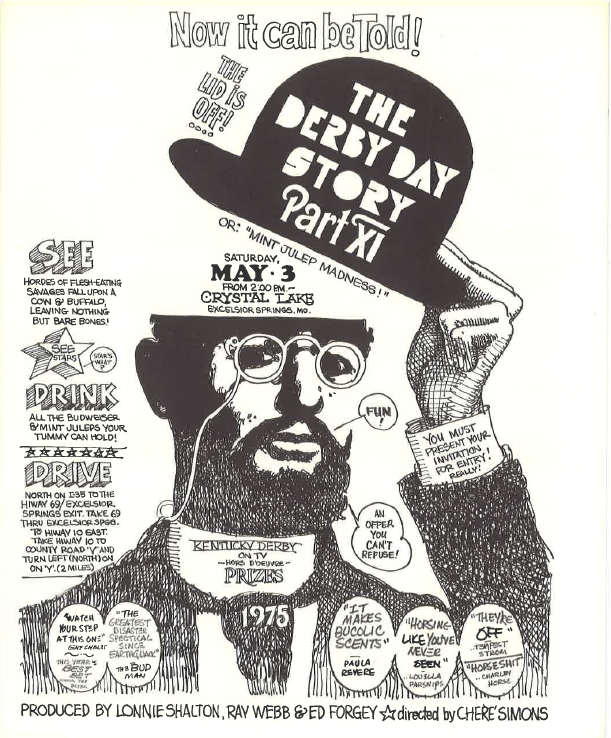
And then it ended. It became too big. Or we became too old. Or whatever. But lots of good stories survive.
1978 Triple Crown – Affirmed v. Alydar: In 1978, a new Triple Crown winner emerged from a duel that ranks in the top individual rivalries in sports. Ali v. Frazier. Martina v. Chrissie. Larry v. Magic. Palmer v. Nicklaus. Affirmed v. Alydar.
Affirmed won all three races. Alydar was second each time. In the Derby, Affirmed won by 1.5 lengths. The Preakness, by a head. The Belmont, by a nose (see video here). That is a total of about 15 feet in races that add up to almost four miles.
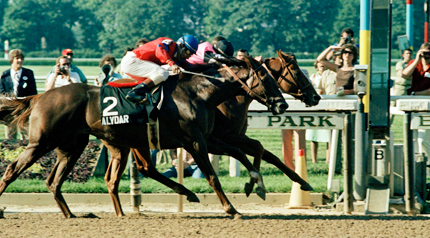
Affirmed noses out Alydar at the 1978 Belmont
2018 – Justify – Two Down, One to Go: In the 40 years since Affirmed won the Triple Crown in 1978, 15 horses have won the first two jewels of the Triple Crown. The first 13 of those did not win the Belmont and lost their Triple Crown dream. The 14th was American Pharoah who won the Belmont in 2015. Next up is Justify. Stay tuned.
Lonnie’s Jukebox – The Boss: In the last Hot Stove post, I spoke of how Bill Shapiro’s rock ‘n’ roll passion was jump-started in January of 1956 when he saw Elvis Presley on the Dorsey TV show. My parents had likewise seen Presley on the show and that’s how I (then 14) found out about this new phenom. Over this past Memorial Day weekend, I heard a similar story about a seven-year-old who saw Elvis on the Ed Sullivan show in the fall of 1956. The kid immediately asked his mother for a guitar – and that’s how Bruce Springsteen got started.
Rita and I heard this story from Bruce himself on the stage of the Walter Kerr Theater. We were in New York for our annual binge of Broadway shows. We saw five, but Springsteen was easily the highlight. We had seen Bruce with his E Street Band in 2008 at Sprint Center in Kansas City. Without a doubt, one of the all-time great rock ‘n’ roll concert bands. But our New York show was quite different. This is a one-man tour de force in an intimate setting. I’ll let Rita describe the show.
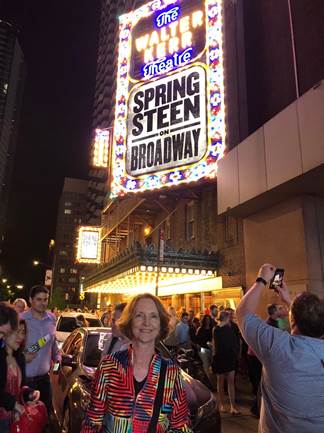
Above, Rita as she left the show. Her take:
“The unexpected pleasure. That’s what happens in NY with StubHub, 5 hours before showtime. We got Orchestra Center seats 18 rows from the stage. And from the moment Bruce took the stage, the crowd practically levitated in their seats. They don’t call him ‘The Boss’ for nothing. And when one enthusiastic fan yelled out something, he was told, ‘This is a one-man show’ and it didn’t happen again.
Two hours, twenty minutes of uninterrupted story and song, without notes or hesitation. His memoir of family stories – and life bursting with fire. Whether he was accompanying himself on a changing selection of guitars or being the piano man to provide depth to his stories, he was a wondrous Broadway experience.
Perhaps my favorite line was when describing his work history, he said he had never worked five days a week…until now. May he continue to work five days a week for the absolute enjoyment of those lucky 948 souls who fill the theater each night.”
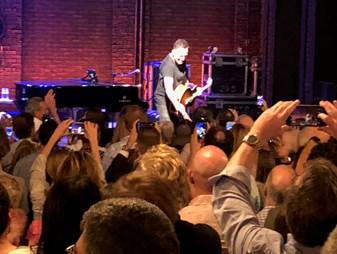
Above, Bruce after the show (no photos allowed during the show).
There is an obvious choice for a Springsteen song title to describe the Thoroughbreds winning the Triple Crown. “Born to Run” – click here. In this video, note the sax solo by the late Clarence Clemons. During Springsteen’s Broadway show, he gives a poignant remembrance of Clarence who played in the E Street Band from 1972 to 2011.
One thought on “Hot Stove #76 – The Triple Crown – Baseball and Horse Racing”
Comments are closed.